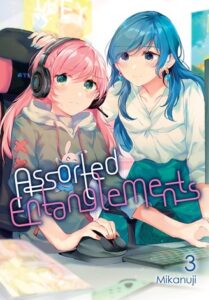 by Matt Marcus, Staff Writer
by Matt Marcus, Staff Writer
Previously in Assorted Entanglements Volume 2, sparks and virtual bullets flew as we met mangaka Heke-sensei and her editor Shinohara, who not-so-anonymously play an online First Person Shooter game together while harboring mutual crushes. Meanwhile, Shizuku and Shiori slowly float closer to each other, somehow.
For Assorted Entanglements Volume 3, Mikanuji-sensei must’ve thought “hmmm the last new couple was a little too wholesome. It’s time to spin the Wheel! Of! Problematic! ‘Ships!” A giant prize wheel rolls in and is vigorously spun. Plasticky ratcheting sounds burst out then slowly decelerate as the selection arrow slowly passes over OL x JK, then Sister x Sister (Adopted), and finally Sister x Sister (Not Adopted) before landing on: Teacher x Student. A sizzle reel plays for the winning couple. For some reason they are riding jet skis at a Sandals Resort.
That’s probably not how it happened (I’m sure there was an editor involved somewhere). However, it is less dire than you may be thinking. For now.
Our new pair of star-crossed acquaintances is the stoic gym teacher Kujou and one of her students, 3rd year Sugimoto. Every day after school, Kujou stands outside the door of a lesbian bar, too afraid to enter. Inevitably, she chickens out and instead frequents the maid café next door where Sugimoto works. Sugimoto, who is a bit of a misanthropic loner despite her good looks, decides seemingly on a whim that she is going to help Kujou on her quest to enter the bar and finally find herself a girlfriend.
It becomes clear pretty quickly that Sugimoto is on her way to catching feelings for Kujou; blessedly, her gym teacher doesn’t even register her as an option, despite noticing that her student is pushing the boundaries of a proper teacher/student relationship. (I hate that I find this refreshing.) Regardless, the comedic dynamic between these two works. Sugimoto’s acerbic tongue is a fun foil to Kujou’s sad puppy vibes. I’m just mildly concerned about where the story is going to take them.
Aside from these two, there are still three other “couples” to check in on. Not too much has changed between Minami and Iori, however the same can’t be said for their “jilted” hangers-on. In fact, Shizuku’s hard-assery has softened considerably towards Shiori, much to the latter’s chagrin. You can see the little dance they are doing, inching towards each other then repelling apart mostly because Shiori likes to throw Shizuku’s feelings back in her face to goad her into anger for a laugh. Despite that, progress is being made. For some reason, I’m rooting for them.
Meanwhile, Heke-sensei and Shinohara begin spending more and more time with each other, often pretending to be lovers for “material” to inspire Heke-sensei’s storyboarding. Each time Heke-sensei tries to close the gap, Shinohara’s bluntness and desire to hide her crush ends up unintentionally sending the wrong signals to her coworker/secret gaming buddy. They are the goofiest and most wholesome pairing in this series, so it’s always a nice reprieve when they show up.
I mentioned the art’s Same Face Syndrome in my review of Volume 2, but somehow the issue has now spread to entire characters. You can’t have your characters say a line like “you should be able to recognize your students” and then give multiple characters 99% the same face and haircut.

These are three different characters. Two of them are 12 years apart in age. No, I can’t tell them apart either.
Also, every now and then there’s some weird body proportions. There’s one panel in particular where Shinohara’s right arm appears to have grown 30% too big for her body.
The thing that continues to hold my interest is the humor (again, shoutout to Eleanor Ruth Summers for the excellent localization). Unfortunately, there are still moments of “yikes” that keep me from truly singing its praises. It’s like eating that PB&J sandwich you packed with you to the beach: no matter how careful you are, you will get a bite or two of sand that feels like it’ll crack your teeth. In one notable case, Minami is acting passive-aggressively and Iori has no idea why, and it turns out that she is grumpy because the night before, Iori, who was blackout drunk, did something out of pocket in bed. It’s supposed to be a reversal joke, but there’s enough “ick” to it that it is hard to handwave, let alone laugh at it. The series continues to be one that has enough rough spots to make it difficult to recommend.
But despite my complaints…I am still reading it. This is perhaps the funniest volume so far, and there’s plenty of joy to be had in cropping out panels as reaction images or meme fodder. You just have to be OK taking your Yuri with a grain of sand.
Art – 6 Seems like the art has regressed a touch, and the sameness of the character designs is not helping
Story – 7 A handful of questionable choices hurt it, but the humor stays sharp
Characters – 7 This really is a manga for people who like Women/Girls Who Suck
Service – 4 Iori and Minami’s sex life is still present, and it is a little uncomfy in a couple places
Yuri – 9 / LGBTQ – 9 You did hear me say lesbian bar, ya?
Overall – 7 I’d tell it to run a few extra laps
Volume 4 is currently available in English from Yen Press, with Volume 5 arriving in June. A twisted Yuri comedy with some punch.
 Matt Marcus is a serial enthusiast whose range of appreciations include guitars, watches, and a particular genre of Japanese popular media named after a flower. Outside of writing for Okazu, he cohosts various projects on the Pitch Drop Podcast Network, where he frequently bloviates about video games, anime, and manga. He also hosts a blog Oh My God, They Were Bandmates analyzing How Do We Relationship in greater depth.
Matt Marcus is a serial enthusiast whose range of appreciations include guitars, watches, and a particular genre of Japanese popular media named after a flower. Outside of writing for Okazu, he cohosts various projects on the Pitch Drop Podcast Network, where he frequently bloviates about video games, anime, and manga. He also hosts a blog Oh My God, They Were Bandmates analyzing How Do We Relationship in greater depth.
![]() College life has become a little more normalized for both Kase-san and Yamada. Yamada’s got a job, and loves her classes. Kase-san is still struggling with her unregulated emotions about Yamada, and with her so focused on Yamada, she’s not really noticing what’s going on in her her own dorm room, where Kase-san’s roommate, Fukami, is going through some stuff on her own.
College life has become a little more normalized for both Kase-san and Yamada. Yamada’s got a job, and loves her classes. Kase-san is still struggling with her unregulated emotions about Yamada, and with her so focused on Yamada, she’s not really noticing what’s going on in her her own dorm room, where Kase-san’s roommate, Fukami, is going through some stuff on her own.

